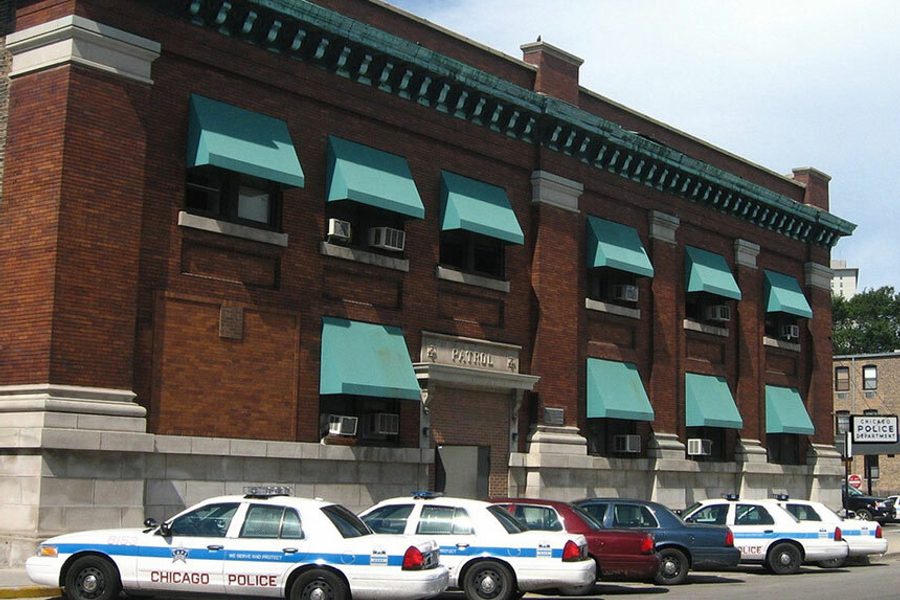To Reform the Police, We Have To Expand Democratic Power Over Them
Technocratic tinkering will not solve the American problem of police brutality and community distrust of law enforcement.
Ben Rosenfield

High-profile police killings of people of color have brought systemic racism back into the news in recent years. The discussion naturally leads to a question: how to fix it? Two recent proposals in Chicago seek to answer that question — one by tinkering with the real estate of police repression, the other by expanding community control and democracy.
The former has come from Jeanne Gang, a Chicago-based architect most famous for the 82-story Aqua Tower north of Millennium Park. Gang and her architectural firm, Studio Gang, put forth their project, Polis Station, at the recent Chicago Architecture Biennial. In Greek, the word “polis” implies a sense of community and the healthy functioning of a society. Polis Station seeks to reform police/community relations by redesigning the current police station and the surrounding area.
After studying the architectural history of police stations, Gang and her team found that such stations had become increasingly isolated from their surroundings. Today, police stations resemble fortresses, closed-off and foreboding structures that appear separate from the rest of society.
In changing the structure of the police station, Gang hopes to encourage more positive interactions between the community and police. The project seeks to transform the police station into a community center, with the goal of “police officers [becoming] atomized and part of the community.” Her proposal includes computers with public internet access in the police stations, shared athletic facilities for community members and police, police housing in neighborhoods where there is a significant number of vacant properties, community gardens and more.
The project centers on the 10th district on Chicago’s West Side, which has been rated the seventh most violent out of Chicago’s 22 police districts. On October 4, 2015, Studio Gang, along with the Chicago Police Department, the City of Chicago, and 24th Ward Alderman Michael Scott Jr. presented the completion of a new basketball court in a previously abandoned parking lot of the 10th district police station, representing a small but tangible manifestation of Gang’s proposals.
Several weeks later, a panel convened to discuss the potential merits of the project. One of the panel members, Ghian Foreman, executive director of the Greater Southwest Development Corporation on Chicago’s South Side and civilian member of the Chicago Police Board remarked that Polis Station will, at the very least, “force us as a community and a city to come up with some solutions” to the problem of the relationship between the police and community members. The Chicago Tribune echoed Foreman’s statement, praising the project’s attempt to generate discussion.
Some of these proposals sound good. Who could be against giving more computers and community garden space to communities in need? Yet the Polis Station proposal leaves much to be desired.
For one thing, the implementation of Gang’s project would ultimately establish constant surveillance of community members, inserting the police in frequently used, important public spaces. Living in a community with police officers in the community and recreation centers, as well as parks and streets, might serve to heighten animosity between the police and community members — particularly if there no fundamental change in the role police play in society. The causes of tension between the police and community members have to do with power relations and control. Seeing a police officer on the way to school and again later that afternoon will not increase trust between the two groups, because people still know that that police officer could still get away with murder. The question isn’t one of trust and exposure to the police, but rather one of having power over them so as to not live in fear of them. It is necessary to put mechanisms in place which actually hold the police accountable for their actions; to do so, we have to change the dynamics of power at the heart of current problems with the police.
While some might argue that those mechanisms and institutions already exist, the killing of 17-year-old Chicagoan Laquan McDonald provides a tragic example of the fundamental flaws and inadequacies of the current system. McDonald was shot 16 times by Chicago Police Department (CPD) officer Jason Van Dyke in October 2014, setting off a chain of events which has served as a scathing indictment of Chicago’s criminal justice system. From missing audio from a CPD dashcam video, to a speedy settlement with McDonald’s family, not to mention the timing of Emanuel’s re-election bid, the hundreds of emails and documents made public by the Emanuel administration shed light on the need for change.
Featured in the emails and documents made public is the independent police review authority (IPRA), an institution tasked with investigating incidents of police misconduct. IPRA is supposed to provide an independent check on police authority. The emails revealed that IPRA was by no means acting independently of Mayor Emanuel and City Hall. In fact, the documents suggest that City Hall and the Emanuel administration played a significant role in crafting the IPRA’s statements.
Much more than architectural tweaks offered by Polis Station, or nominally “independent” institutions such as IPRA, we need truly independent governing bodies that limit police power if we’re going to stop the killings by police. Any attempt to resolve the problem should seek to assert control over the police, by giving people power over the police who are supposed to protect them.
The Civilian Police Accountability Council (CPAC) proposes to do just this.
CPAC is a proposal drafted by the Chicago Alliance Against Racist and Political Repression (CAARPR), along with representatives from community-based organizations. CPAC aims to establish democratic, civilian control of the police through an elected council of civilians from every police district in the city. CPAC would have the authority to appoint the superintendent of police, investigate police misconduct and all police shootings, indict police officers for crimes they commit and re-write the police rule book, including all use of force guidelines. As CAARPR leader Mike Siviwe Elliot stated, CPAC would “empower people in the community to control how their neighborhoods are policed.”
Elliot moves beyond the issue of police killings and the role of the police in society, however, stating that his groups strategy to win “community control of the police is based on participating in and supporting other struggles in housing, schools, and workplaces, against austerity and against exploitation. … [L]inking up with other struggles, building coalitions across the board, [will] help us grow our movement.” CAARPR argues that democratic control of the police is critical, but that it is also must be part of a larger process of re-democratizing society.
Changing the architecture of police stations might not be a bad thing. But police violence against people of color isn’t a result of bad layouts of those stations. It’s a result of the unchecked power that police wield and a system designed to obstruct justice. By operating without accountability behind institutions which lack transparency and protect police no matter how heinous their crimes, they have been allowed to systematically kill citizens, especially people of color. Bringing the police under the democratic control of the people is the only real way to confront this issue.
We live in an era in which bureaucratic and technocratic approaches have been increasingly employed as the only way to solve society’s problems. But when it comes to racism and policing, we actually need a more old-fashioned solution: giving the people democratic power to affect the decisions which affect their lives.





